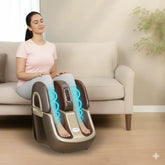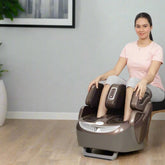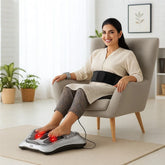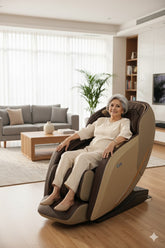Choosing the right treadmill for your home can be a daunting task, especially with the variety of options available. Two of the most popular types are manual treadmills and electric treadmills. Each type has its unique benefits and drawbacks, and understanding these can help you make an informed decision. In this blog, we will compare manual and electric treadmills, focusing on their features, benefits, and which one might be the best fit for your home fitness needs.
Overview of Manual and Electric Treadmills
Manual Treadmills
Manual treadmills, such as the JSB HF38, are non-motorized and powered solely by your movement. This type of treadmill requires the user to push the belt with their feet, which can provide a more intense workout.
Electric Treadmills
Electric treadmills, like the JSB Electric Treadmill with Slimming Belt, are motorized and come with a variety of features such as adjustable speeds, incline settings, and built-in workout programs. These treadmills are powered by electricity, providing a consistent and adjustable workout experience.
Key Differences Between Manual and Electric Treadmills
- Power Source
- Manual Treadmills: Operate without electricity, making them eco-friendly and less expensive to run.
- Electric Treadmills: Require electricity to power the motor, providing a consistent and smooth operation.
- Cost
- Manual Treadmills: Generally more affordable upfront, with lower maintenance costs.
- Electric Treadmills: Typically more expensive due to advanced features and motorized components.
- Workout Intensity
- Manual Treadmills: Can provide a more intense workout as you have to propel the belt yourself, engaging more muscle groups.
- Electric Treadmills: Offer a controlled workout with adjustable speed and incline settings, suitable for various fitness levels.
- Features and Functionality
- Manual Treadmills: Simpler design with fewer features. Typically includes basic metrics like speed, time, and distance.
- Electric Treadmills: Equipped with advanced features such as pre-set workout programs, heart rate monitors, and interactive displays.
- Space and Storage
- Manual Treadmills: Often lighter and more compact, making them easier to move and store.
- Electric Treadmills: Larger and heavier, requiring more space but often foldable for storage.
Benefits of Manual Treadmills
- Cost-Effective
- Lower initial cost and minimal maintenance expenses make manual treadmills budget-friendly.
- Portability
- Lightweight and compact design allows for easy movement and storage.
- Intense Workout
- Requires more effort to operate, leading to a more intense workout that can help build endurance and muscle strength.
- No Electricity Needed
- Eco-friendly option that can be used anywhere without the need for power outlets.
Benefits of Electric Treadmills
- Versatility
- Wide range of speeds, incline settings, and workout programs cater to various fitness levels and goals.
- Ease of Use
- Motorized operation provides a smooth and consistent workout experience, ideal for all fitness levels.
- Advanced Features
- Equipped with interactive displays, heart rate monitors, and connectivity options for a more engaging workout.
- Comfort
- Adjustable cushioning and incline settings make workouts more comfortable and reduce impact on joints.
Choosing the Right Treadmill for Your Home
Consider Your Fitness Goals
- For Intense Workouts: If you’re looking for a treadmill that offers a more intense workout and engages more muscle groups, the JSB HF38 Manual Treadmill might be the right choice.
- For Versatility and Convenience: If you prefer a treadmill with multiple features, adjustable settings, and a smoother operation, the JSB Electric Treadmill with Slimming Belt is ideal.
Evaluate Your Space and Budget
- Limited Space and Budget: Manual treadmills are generally more affordable and compact, making them suitable for smaller spaces and tighter budgets.
- More Space and Higher Budget: Electric treadmills, while more expensive and larger, offer a range of features that justify the investment if you have the space and budget.
Think About Usability
- Simplicity: Manual treadmills are straightforward and require no setup or electricity, perfect for those who prefer simplicity.
- Advanced Options: Electric treadmills provide a range of settings and features that can enhance your workout experience, suitable for tech-savvy users.
Maintenance Tips for Both Treadmill Types
Manual Treadmills
- Cleaning: Wipe down the treadmill after each use to remove sweat and dust. Clean the belt and deck monthly to prevent debris buildup.
- Lubrication: Lubricate the belt and rollers periodically to ensure smooth operation.
- Inspection: Regularly check for any signs of wear and tear, such as frayed belts or loose bolts.
Electric Treadmills
- Cleaning: Clean the console, belt, and deck regularly. Avoid using harsh chemicals that can damage the components.
- Lubrication: Follow the manufacturer’s guidelines for lubricating the belt and motor.
- Inspection: Check the treadmill for any loose parts or electrical issues. Ensure the motor and other components are free from dust and debris.
FAQs
- Which type of treadmill is better for beginners?
- Electric treadmills are generally better for beginners due to their ease of use, adjustable settings, and built-in workout programs.
- Can manual treadmills be used for running?
- While manual treadmills can be used for running, they are more suited for walking or jogging due to the effort required to propel the belt.
- How often should I lubricate my treadmill?
- For manual treadmills, lubrication is needed less frequently but should be checked periodically. Electric treadmills typically require lubrication every three months or as recommended by the manufacturer.
- Are manual treadmills safe for older adults?
- Manual treadmills can be safe for older adults if used properly, but electric treadmills may be more suitable due to their controlled speed and ease of use.
- Do electric treadmills consume a lot of electricity?
- Electric treadmills consume electricity, but the amount is generally comparable to other household appliances. Energy-efficient models are available to minimize consumption.
Conclusion
Choosing between a manual and an electric treadmill depends on your fitness goals, budget, and personal preferences. Both types have their unique benefits and can provide effective workouts at home. By understanding the differences and considering your specific needs, you can select the best treadmill for your home fitness routine. Whether you opt for the JSB HF38 Manual Treadmill or the JSB Electric Treadmill with Slimming Belt, investing in a quality treadmill will help you stay active, healthy, and committed to your fitness journey.












